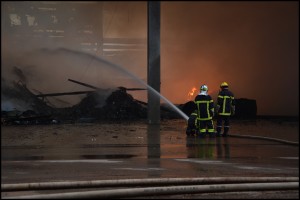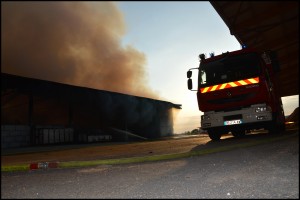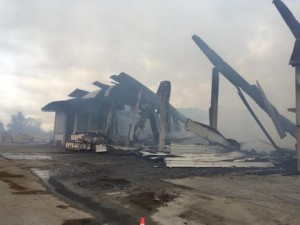At around 6:35 p.m., a fire broke out in a sorting centre within a 4,000 m² building covered with photovoltaic panels. The building was being used to store 400 m³ of waste, a sorting line for waste derived from economic activities, a compressor and a generator. A significant plume of smoke was released, while the firefighters attempted to put out the flames with 8 fire hoses. At 11:00 p.m., part of the roof collapsed. At that point, the emergency rescue services encountered difficulties when trying to enter the facility due to the presence of photovoltaic panels and the risk that the rest of the building could collapse. Over a period of 3 days, they cleared out the area and sprayed down the waste. The intervention finally ended at 8 p.m., four days after the fire initially started.
Consequences
The economic activity waste sorting building was completely destroyed. The other two buildings on the site and mainly the one used sorting waste from selective waste collection activities were not affected. The damage was estimated at €25 M.
The favourable weather conditions allowed for good dispersion of the smoke. The extinguishing water was confined in the retention basins provided for that purpose.
The waste that was contaminated by the fire was sent to a storage facility. For one week, the economic activity waste received could no longer be treated on site and was therefore sent to storage. Subsequently, the sorting line for waste from the selective collection of household waste was also used to sort waste from economic activities.
Causal analysis
The fire allegedly started after the last three containers of economic activity waste had been unloaded at the end of the day. One of the skips must have contained waste other than what was expected, and in fact, many small explosions had been observed during the fire.
The building was not equipped with a fire detection system. The incriminated waste had been left unattended at the end of the day.
The existence of the sorting line for economic activity waste, which has been in operation since late 2014, had not been brought to the attention of the inspection authorities for classified facilities. The same was true for several modifications made to the installations over time (different location of buildings, modifications of storage facilities and basins, and the evolution of activities).
A fire had already occurred on the site in July 2013 (ARIA 44131) at the wood storage and composting platform. The hazard study had not been updated since that time despite a request submitted by the inspection authorities for classified facilities.
The operator must update its authorisation request file and, in particular, the analysis of the risks associated with the activities performed at the site.






